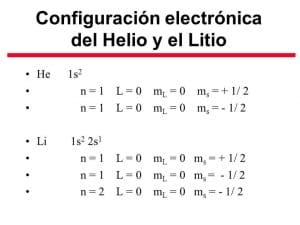Lithium Electron Configuration Explained

The fascinating world of atomic physics, where the arrangement of electrons within an atom determines its properties and behavior. Lithium, with its atomic number of 3, is a unique element that plays a crucial role in various fields, from energy storage to pharmaceuticals. In this comprehensive guide, we’ll delve into the lithium electron configuration, exploring its significance, notation, and the implications of its electronic structure.
Introduction to Electron Configuration
Before we dive into lithium’s electron configuration, let’s briefly review the concept of electron configuration. Electron configuration refers to the arrangement of electrons within an atom, which is typically represented using the Aufbau principle and the Pauli exclusion principle. The Aufbau principle states that electrons fill the lowest available energy levels, while the Pauli exclusion principle dictates that no two electrons can occupy the same energy state simultaneously.
Lithium Electron Configuration Notation
The electron configuration of lithium is represented as 1s² 2s¹. This notation indicates that lithium has two electrons in the 1s orbital and one electron in the 2s orbital. The 1s orbital is the lowest energy level, and the 2s orbital is the next available energy level. The superscript numbers (² and ¹) represent the number of electrons occupying each orbital.
Understanding the 1s and 2s Orbitals
To grasp the lithium electron configuration, it’s essential to understand the characteristics of the 1s and 2s orbitals. The 1s orbital is the closest to the nucleus and has a spherical shape, with a high probability of finding electrons near the nucleus. The 2s orbital, on the other hand, is larger and has a more complex shape, with a higher energy level than the 1s orbital.
Implications of Lithium’s Electron Configuration
The unique electron configuration of lithium has significant implications for its chemical and physical properties. Lithium’s single electron in the 2s orbital makes it highly reactive, as it readily loses this electron to form a positive ion (Li⁺). This reactivity is responsible for lithium’s high electrochemical reactivity, making it an ideal material for battery applications.
Comparison with Other Elements
Lithium’s electron configuration is distinct from other elements in its group (Group 1) and period (Period 2). For example, sodium (Na) has an electron configuration of 1s² 2s² 2p⁶, while potassium (K) has an electron configuration of 1s² 2s² 2p⁶ 3s² 3p⁶. These differences in electron configuration contribute to the unique properties of each element, highlighting the importance of understanding electron configuration in determining an element’s behavior.
Real-World Applications
Lithium’s electron configuration has far-reaching implications in various industries. Some notable applications include:
- Lithium-Ion Batteries: Lithium’s high reactivity and ability to easily lose electrons make it an ideal material for battery applications. Lithium-ion batteries are widely used in portable electronics, electric vehicles, and renewable energy systems.
- Pharmaceuticals: Lithium is used in the treatment of certain mental health conditions, such as bipolar disorder. Its unique electron configuration and reactivity contribute to its therapeutic effects.
- Nuclear Applications: Lithium is used in the production of tritium, a rare and radioactive isotope, which has applications in nuclear fusion research and nuclear medicine.
What is the electron configuration of lithium?
+The electron configuration of lithium is 1s² 2s¹.
Why is lithium highly reactive?
+Lithium's single electron in the 2s orbital makes it highly reactive, as it readily loses this electron to form a positive ion (Li⁺).
What are some real-world applications of lithium's electron configuration?
+Lithium's electron configuration has implications in various industries, including lithium-ion batteries, pharmaceuticals, and nuclear applications.
In conclusion, the lithium electron configuration is a fundamental aspect of its atomic structure, determining its chemical and physical properties. Understanding the implications of lithium’s electron configuration is crucial for harnessing its potential in various applications, from energy storage to pharmaceuticals. By exploring the intricacies of electron configuration, we can unlock the secrets of the atomic world and develop innovative solutions to real-world challenges.